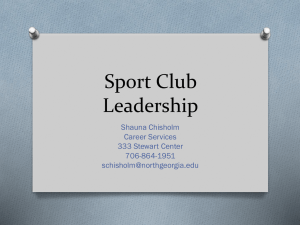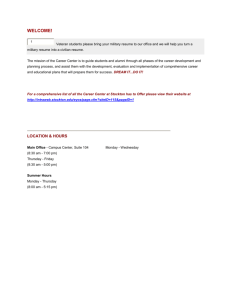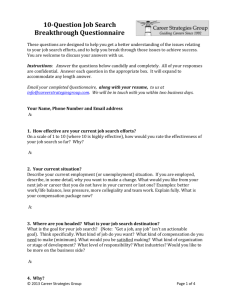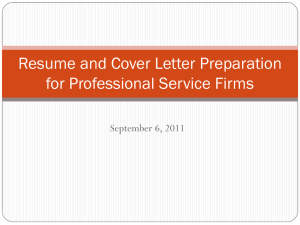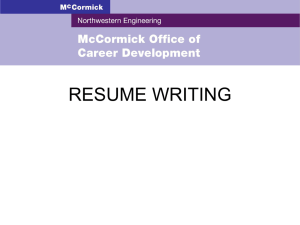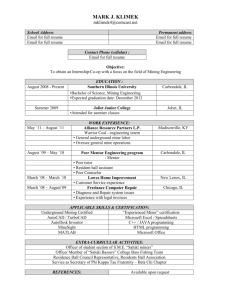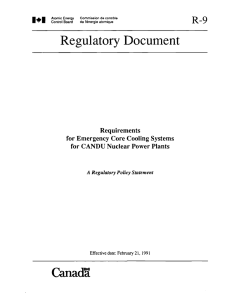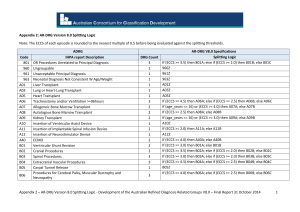resume checklist
advertisement
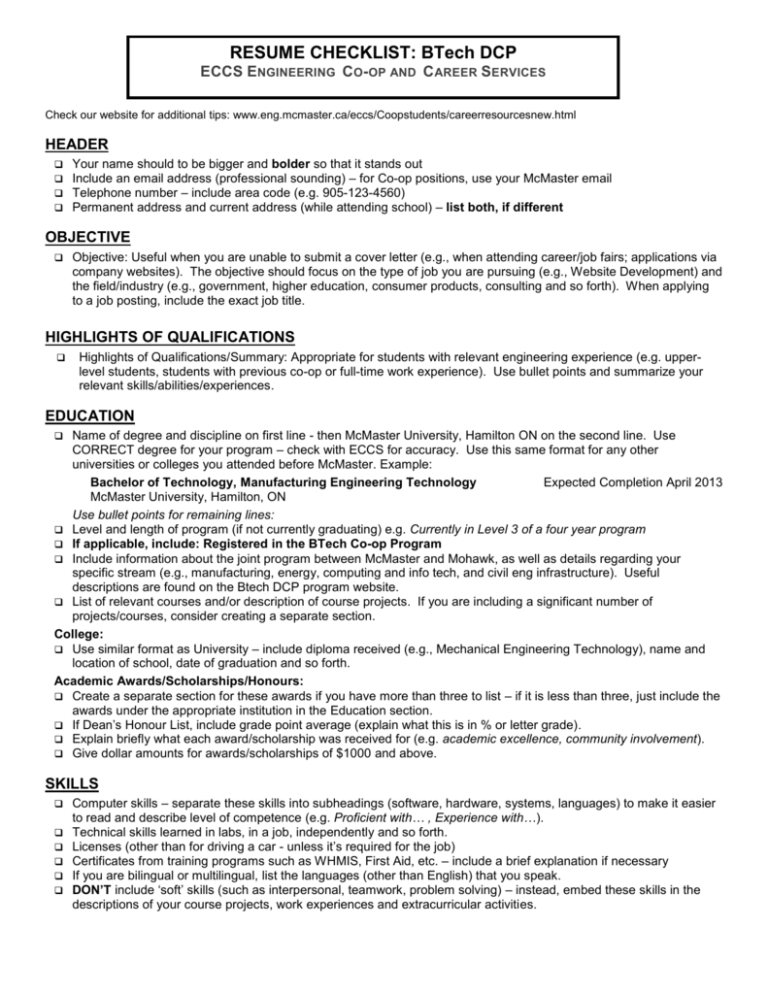
RESUME CHECKLIST: BTech DCP ECCS ENGINEERING CO-OP AND C AREER SERVICES Check our website for additional tips: www.eng.mcmaster.ca/eccs/Coopstudents/careerresourcesnew.html HEADER Your name should to be bigger and bolder so that it stands out Include an email address (professional sounding) – for Co-op positions, use your McMaster email Telephone number – include area code (e.g. 905-123-4560) Permanent address and current address (while attending school) – list both, if different OBJECTIVE Objective: Useful when you are unable to submit a cover letter (e.g., when attending career/job fairs; applications via company websites). The objective should focus on the type of job you are pursuing (e.g., Website Development) and the field/industry (e.g., government, higher education, consumer products, consulting and so forth). When applying to a job posting, include the exact job title. HIGHLIGHTS OF QUALIFICATIONS Highlights of Qualifications/Summary: Appropriate for students with relevant engineering experience (e.g. upperlevel students, students with previous co-op or full-time work experience). Use bullet points and summarize your relevant skills/abilities/experiences. EDUCATION Name of degree and discipline on first line - then McMaster University, Hamilton ON on the second line. Use CORRECT degree for your program – check with ECCS for accuracy. Use this same format for any other universities or colleges you attended before McMaster. Example: Bachelor of Technology, Manufacturing Engineering Technology Expected Completion April 2013 McMaster University, Hamilton, ON Use bullet points for remaining lines: Level and length of program (if not currently graduating) e.g. Currently in Level 3 of a four year program If applicable, include: Registered in the BTech Co-op Program Include information about the joint program between McMaster and Mohawk, as well as details regarding your specific stream (e.g., manufacturing, energy, computing and info tech, and civil eng infrastructure). Useful descriptions are found on the Btech DCP program website. List of relevant courses and/or description of course projects. If you are including a significant number of projects/courses, consider creating a separate section. College: Use similar format as University – include diploma received (e.g., Mechanical Engineering Technology), name and location of school, date of graduation and so forth. Academic Awards/Scholarships/Honours: Create a separate section for these awards if you have more than three to list – if it is less than three, just include the awards under the appropriate institution in the Education section. If Dean’s Honour List, include grade point average (explain what this is in % or letter grade). Explain briefly what each award/scholarship was received for (e.g. academic excellence, community involvement). Give dollar amounts for awards/scholarships of $1000 and above. SKILLS Computer skills – separate these skills into subheadings (software, hardware, systems, languages) to make it easier to read and describe level of competence (e.g. Proficient with… , Experience with…). Technical skills learned in labs, in a job, independently and so forth. Licenses (other than for driving a car - unless it’s required for the job) Certificates from training programs such as WHMIS, First Aid, etc. – include a brief explanation if necessary If you are bilingual or multilingual, list the languages (other than English) that you speak. DON’T include ‘soft’ skills (such as interpersonal, teamwork, problem solving) – instead, embed these skills in the descriptions of your course projects, work experiences and extracurricular activities. EXPERIENCE Use the job posting to guide you in selecting experience to include, as well as the specific points (e.g., keywords). Embed job posting keywords – both TECHNICAL and SOFT skills - in descriptions of experience (even for nonengineering positions) – many employers conduct electronic screens before viewing submitted resumes. For current students, experience can be paid OR volunteer work, as well as significant extracurricular activities (e.g., being the treasurer for a student society) Position job title first – then employer, city and province listed on the second line (if outside Canada, list country) Dates worked should be listed at the far right on the employer line (e.g. May – August 2010) Use bullet points for remaining lines: Describe clearly WHAT you did, include activities demonstrating responsibility and technical complexity Give outcomes to demonstrate how each job that you performed helped the employer and include achievements wherever possible. Quantify and/or qualify your descriptions to paint a clear picture and illustrate competencies Describe what you achieved, learned, contributed or were commended for by supervisors or coworkers, picking the most significant for each position. If applicable, include number of hours worked per week while attending school full-time. Utilize better action verbs (e.g. coordinated, organized, developed, initiated) to begin each job responsibility, and consider highlighting skills obtained in job as last bullet point for each job. Should be written in past tense. Jobs should be listed in reverse chronological order, starting with most recent, and list most recent positions (may distribute between relevant and additional sections) – usually no more than three or four jobs. If one (or more) positions may be related to the type of work to which you are applying, consider splitting this section in two: one titled Relevant Experience, and the other titled Additional Experience. EXTRACURRICULAR ACTIVITIES AND INTERESTS This section MUST be included on the resume. If you need ideas for extracurricular/volunteer activities, please speak with a Career Advisor at ECCS. Utilize this section to discuss activities other than just school/work to show that you are a well-rounded individual and illustrate attributes that may not be evident in your Experience section. Include: Clubs and associations, whether active or just a member. Include leadership roles and your achievements, membership size and purpose of the club. Volunteer work – position, where, when, what you do/did, number of hours per week. If substantial, may include as a separate section with a heading of Volunteer Experience. Interests related to engineering or technical expertise (e.g. repairing cars/computers, developing websites, etc.). Any other skill-based interests and hobbies outside of school and work, including musical, athletic, arts, reading and so forth. FORMAT/PRESENTATION The overall appearance of your resume will affect how a potential employer views you as a job candidate. The format that you use for your resume should be clear, concise and easy-to-read. Use one font style throughout your resume. Font should match that of your cover letter. Third-person only (e.g. no “I” or “my” statements) Use bullets points for descriptions (easier to read) For dates, list month and year only and be consistent throughout resume. Position dates at the end of the line (aligned with the right margin using a right-hand tab) Too much (or too little) “empty” space on resume (adjust fonts, margins, be concise with information) Use formal writing style (no jargon) and British (UK) spelling List your name (and either a phone number or email address) on second page in case pages get separated Section headings need to stand out (bigger and bolder). Section should be ordered as: Education, Relevant Experience/Additional Experience, Skills, Extracurricular Activities (depending on format/content, may switch the “experience” and “skills” sections) Resume is too long / too short (two pages is standard) <Add “References Available Upon Request” at bottom of 2nd page if you need to fill space>
